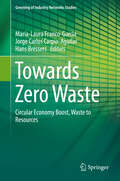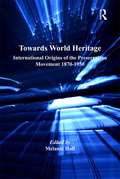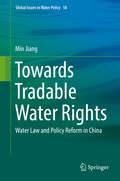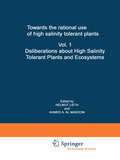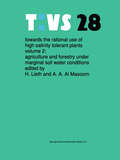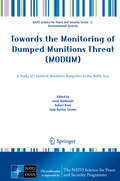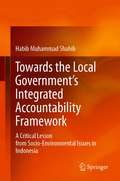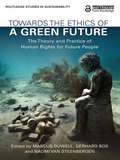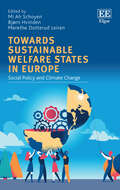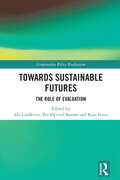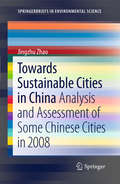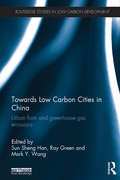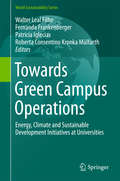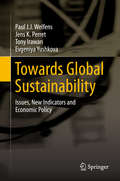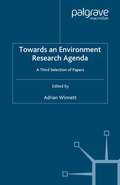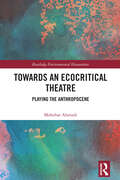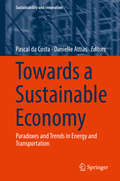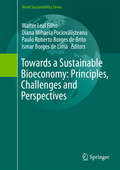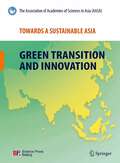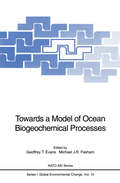- Table View
- List View
Towards Zero Waste: Circular Economy Boost, Waste to Resources (Greening of Industry Networks Studies #6)
by María-Laura Franco-García Jorge Carlos Carpio-Aguilar Hans BressersThis book draws on insights that originated from the Circular Economy and Zero Waste initiatives. Together these approaches try to boost the shift from “waste” to “resources” management. The content of this book is partially organized from a stakeholder perspective, revealing the managerial implications for public and private actors. Next to public policies, also illustrations come from the private sector. Petstar, Texperium and Walmart generously shared some of their best practices at in this regard. Cases from China, Indonesia, Mexico, the Netherlands and Romania are discussed in this book. In all of these different contexts they show ways to create collaborative schemes in order to “retain” the resources’ values as much as product quality and financial circumstances permit. The reader can thus take advantage of the pragmatic viewpoints that aim to inspire policy makers, researchers, students, organisations and communities to boost the needed changes towards a Zero Waste Economy.
Towards World Heritage: International Origins of the Preservation Movement 1870-1930
by Melanie HallHistoric preservation, whether of landscapes or buildings, was an important development of the nineteenth century in many countries. There is however surprisingly little understanding about how it took place, and research into it is narrowly focused. For example, generally landscape preservation from this time is examined separately from buildings; preservation is seen in terms of national narratives, or considered within the contexts of area studies, and it is usually seen from a specific disciplinary perspective. All of these later categorizations did not apply at the time and consequently, a very partial view is achieved. In order to begin unlocking a very complex phenomenon that has helped to define our own age, this dynamic collection of essays brings together an international and transdisciplinary line-up of academics and practitioners to reconsider preservation's origins in the second half of the nineteenth and early part of the twentieth century. With a focus on Britain and the British Empire, and including case studies from the United States, Canada, Sweden, France, Germany, Sri Lanka, 'The Holy Land', and Turkey, this book places preservation in imperial, international, and national contexts, demonstrating that there was far more interaction between different countries in this arena than may be supposed and revealing remarkable but hitherto hidden overlaps and intersections. It examines three main themes: the influence of religion; the political and sub-diplomatic aspects of preservation; and the professionalization of preservation practice. Internationalizing trends already existed through the churches, the universities, and the diplomatic services, as well as familial ties that had an important impact on preservation's epistemic communities and its targets. Other internationalizing factors include an interest in national histories and the histories of architecture and art, particularly when known through illustration; a growing interest in biography especially of 'founding fathers' or famous literary figures; and tourism. Although the focus is on architectural preservation, this book demonstrates that, in this formative period, the preservation of buildings and landscapes needs to be considered together - as it often was at the time - and in context. The conclusion reached is that the preservation movement has to be understood in imperial and international contexts, rather than in simply national or regional ones.
Towards World Heritage: International Origins of the Preservation Movement 1870-1930
by Melanie HallHistoric preservation, whether of landscapes or buildings, was an important development of the nineteenth century in many countries. There is however surprisingly little understanding about how it took place, and research into it is narrowly focused. For example, generally landscape preservation from this time is examined separately from buildings; preservation is seen in terms of national narratives, or considered within the contexts of area studies, and it is usually seen from a specific disciplinary perspective. All of these later categorizations did not apply at the time and consequently, a very partial view is achieved. In order to begin unlocking a very complex phenomenon that has helped to define our own age, this dynamic collection of essays brings together an international and transdisciplinary line-up of academics and practitioners to reconsider preservation's origins in the second half of the nineteenth and early part of the twentieth century. With a focus on Britain and the British Empire, and including case studies from the United States, Canada, Sweden, France, Germany, Sri Lanka, 'The Holy Land', and Turkey, this book places preservation in imperial, international, and national contexts, demonstrating that there was far more interaction between different countries in this arena than may be supposed and revealing remarkable but hitherto hidden overlaps and intersections. It examines three main themes: the influence of religion; the political and sub-diplomatic aspects of preservation; and the professionalization of preservation practice. Internationalizing trends already existed through the churches, the universities, and the diplomatic services, as well as familial ties that had an important impact on preservation's epistemic communities and its targets. Other internationalizing factors include an interest in national histories and the histories of architecture and art, particularly when known through illustration; a growing interest in biography especially of 'founding fathers' or famous literary figures; and tourism. Although the focus is on architectural preservation, this book demonstrates that, in this formative period, the preservation of buildings and landscapes needs to be considered together - as it often was at the time - and in context. The conclusion reached is that the preservation movement has to be understood in imperial and international contexts, rather than in simply national or regional ones.
Towards Tradable Water Rights: Water Law and Policy Reform in China (Global Issues in Water Policy #18)
by Min JiangThis book provides a first comprehensive legal examination of water rights arrangements and water rights trading in China. Although recent water reform in China has made substantial progress in policy development and practice, how its legal and institutional framework facilitates or hinders the application of tradable water rights remains less addressed in the existing scholarship. Against the backdrop of China’s water reform and the wider international debate in water governance, this book aims to provide an innovative approach to the complex issue of water governance by critically analysing the recent legal and policy developments in China towards tradable water rights. It examines the deficiencies of the current systems for water rights arrangements and trading, explores how China may learn from and build on the international trends in water rights trading practice (mainly Australia and the US), and proposes legal and policy frameworks for defining and administering tradable water rights in China that underpin sustainable water use in the face of exacerbated water scarcity, variability, and uncertainty. All in all, the book proposes pragmatic strategies for China’s water law and policy reform to move towards tradable water rights, which encompasses a comprehensive prescription from initialising and defining tradable water rights to administering water rights and trading. By reflecting on the deepening water reforms in both China and other jurisdictions, the book aims to contribute to the international water governance debate by exploring from a legal and policy perspective, how China, comparative to other cases around the world, can find a balanced combination of water allocation mechanisms to address its water challenges. It is hoped that the observations and proposed implications for China’s water reform will contribute to developing a better understanding of the way in which experiences in water markets can be shared from jurisdiction to jurisdiction.
Towards the rational use of high salinity tolerant plants: Vol 1: Deliberations about High Salinity Tolerant Plants and Ecosystems (Tasks for Vegetation Science #27)
by Helmut Lieth A. A. Al MasoomThe symposium on high salinity tolerant plants, held at the University of Al Ain in December 1990, dealt primarily with plants tolerating salinity levels exceeding that of ocean water and which at the same time are promising for utilization in agriculture or forestry. The papers of the proceedings of this symposium have been published in two volumes. This volume (1) deals with mangroves and inland high salinity tolerant plants and ecosystems and is divided into the following categories: 1. Vegetation analyses and descriptions of mangroves; 2. Ecosystem analyses; 3. Physiological analyses; 4. Utilization of mangroves and saltmarsh plants; 5. Soil and water analyses. Volume 2 deals with the improvement of salinity tolerance for traditional crops under marginal soils and irrigation water and is published in `Tasks for Vegetation Science' series (TAVS) Vol. 28.
Towards the rational use of high salinity tolerant plants: Vol 2: Agriculture and forestry under marginal soil water conditions (Tasks for Vegetation Science #28)
by Helmut Lieth A. A. Al MasoomThe Symposium on high salinity tolerant plants, held at the University of Al Ain in December 1990, dealt primarily with plants tolerating salinity levels exceeding that of ocean water and which at the same time are promising for utilization in agriculture or forestry. These plants could be very useful for a country like the UAE where fresh water resources are very scarce and the groundwater available at some places is already very salty. More than 60 million woody trees/shrubs have been planted so far and more are planned for the inland plains underlain with brackish groundwater. These species were no solution for the widely barren shoreline of the UAE. Here mangrove species were of potential use, and one species, Avicennia Marina, occurs widely and has been successfully planted for about a decade. Converting the tree plantations into economically useful cropping systems is still a problem requiring much research and development. The book deals in several sections with conventional irrigation systems using marginal water. The species used in these systems are mostly hybrids of conventional crops. The irrigation systems, however, have similar problems as may be expected for irrigation with seawater. Papers show the participants' experiments in this area. The volume serves as a link between scientists working for the improvement of classical irrigation systems and those interested in the application of a new dimension of salinity levels for irrigation water.
Towards the Monitoring of Dumped Munitions Threat: A Study of Chemical Munitions Dumpsites in the Baltic Sea (NATO Science for Peace and Security Series C: Environmental Security)
by Jacek Bełdowski Robert Been Eyup Kuntay TurmusThis book describes the creation of a monitoring network, which can provide information about the exact locations and the environmental threats posed by chemical weapons (CW) dumpsites in the Baltic Sea region, using autonomous underwater vehicles (AUVs) and remotely operated underwater vehicles (ROVs), and utilising the existing research vessels of NATO partner institutions as launching platforms. The dumping operations occurred shortly after World War II and included captured German munitions. Operations with munitions from the Soviet occupation zone were performed by the Soviet Navy, operations with munitions from British and American occupation zones were performed in areas outside of the Baltic Sea (Skagerrak Strait); the fate of munitions from the French occupation zone was never reported. Due to difficult legal status of these munitions, and high costs of remediation and retrieval, removal of these weapons from the bottom of the Baltic Sea seems unlikely in the foreseeable future. These dumped chemical weapons pose an actual environmental and security hazard in the Baltic Sea Region. Nowadays, with more and more industrial activities being performed in the Baltic Sea Area, the threat level is rising. The AUV survey is based on the IVER2 platform by OceanServer, equipped with Klein 3500 side-scan sonar. The identification phase utilises several ROVs, equipped with targeting sonars, acoustic cameras capable of penetrating turbid bottom waters up to 20m, and visual HD cameras. A novel sediment sampling system, based on a camera and sonar equipped cassette sampler, has been developed to obtain surface sediments. The test phase described consists of a survey phase, which will locate the actual objects concerned, and a monitoring phase, which will concentrate on the collection of environmental data close to the objects concerned.
Towards the Local Government’s Integrated Accountability Framework: A Critical Lesson from Socio-Environmental Issues in Indonesia
by Habib Muhammad ShahibThis book shows the growing phenomenon and the broad impact of socio-environmental conflicts in the grassroots communities—farmers, fishermen and urban poor—in Indonesia, as the effects of government’s development strategies based on neoliberal and New Public Management (NPM) views without a clear accountability system or socio-environmental accountability practices and reports are becoming apparent. Inspired by the emancipatory socio-environmental accounting discourse, which focuses on the socio-local context in developing alternative models of accountability based on local views and people's aspirations, this book uses research methodology based on the principles put forth by Indonesian national hero and critical scholar Tan Malaka to develop a framework of integrated accountability for the local government. This book fills the present gap in English publications that analyse the intents and outcomes of the public management reforms in Indonesia with regard to socio-environmental issues, as a basis for further research at the international level as well as policymaking in Indonesia. As the Indonesian government has recently undertaken key structural and accounting reforms in the public sector, this book is a timely and valuable read for graduate students, researchers,- and policymakers.
Towards the Ethics of a Green Future: The Theory and Practice of Human Rights for Future People (Routledge Studies in Sustainability)
by Marcus Düwell Gerhard Bos Naomi Van SteenbergenWhat are our obligations towards future generations who stand to be harmed by the impact of today’s environmental crises? This book explores ecological sustainability as a human rights issue and examines what our long-term responsibilities might be. This interdisciplinary collection of chapters provides a basis for understanding the debates on the provision of sustainability for future generations from a diverse set of theoretical standpoints. Covering a broad range of perspectives such as risk and uncertainty, legal implementation, representation, motivation and economics, Towards the Ethics of a Green Future sets out the key questions involved in this complex ethical issue. The contributors bring theoretical discussions to life through the use of case studies and real-world examples. The book also includes clear and tangible recommendations for policymakers on how to put the suggestions proposed within the book into practice. This book will be of great interest to all researchers and students concerned with issues of sustainability and human rights, as well as scholars of environmental politics, law and ethics more generally.
Towards the Ethics of a Green Future: The Theory and Practice of Human Rights for Future People (Routledge Studies in Sustainability)
by Marcus Düwell Gerhard Bos Naomi Van SteenbergenWhat are our obligations towards future generations who stand to be harmed by the impact of today’s environmental crises? This book explores ecological sustainability as a human rights issue and examines what our long-term responsibilities might be. This interdisciplinary collection of chapters provides a basis for understanding the debates on the provision of sustainability for future generations from a diverse set of theoretical standpoints. Covering a broad range of perspectives such as risk and uncertainty, legal implementation, representation, motivation and economics, Towards the Ethics of a Green Future sets out the key questions involved in this complex ethical issue. The contributors bring theoretical discussions to life through the use of case studies and real-world examples. The book also includes clear and tangible recommendations for policymakers on how to put the suggestions proposed within the book into practice. This book will be of great interest to all researchers and students concerned with issues of sustainability and human rights, as well as scholars of environmental politics, law and ethics more generally.
Towards Sustainable Welfare States in Europe: Social Policy and Climate Change
This seminal book addresses the critical and urgent question of ‘what makes welfare states sustainable?’ in the era of climate change. Expert authors challenge traditional perspectives on questions of sustainability which have focused on population ageing, global economic turbulence and on containing current and future public social spending.The chapters present new empirical evidence in the form of in-depth comparative country studies from across Europe, offering an insight into how political actors, social partners and civil society organisations in countries associated with different welfare models address questions of sustainability and the extent to which they balance social, ecological and economic considerations. The editors conclude by mapping out ways in which welfare states can address these increasingly urgent and complex issues and facilitate an eco-social transition towards true sustainability.This book will be an invaluable resource for scholars and students of comparative social policy, environmental politics and policy and climate change. Highlighting the political and structural challenges European societies face in the transition to low carbon economies, this book will also be beneficial for policymakers and practitioners in these areas.
Towards Sustainable Futures: The Role of Evaluation (Comparative Policy Evaluation)
by Ida Lindkvist Per Øyvind Bastøe Kim ForssTowards Sustainable Futures serves as a guide to better understand what roles evaluation can play in sustainability. Rather than proposing a single definition of sustainability or methodological approach, this book gives us the tools to improve the quality and relevance of evaluation of sustainability. Divided into two parts, the first part introduces the reader to key debates and challenges related to evaluation of sustainability. Part Two provides examples of methods and applications. By combining a stellar line up of specialists, theorists, and practitioners in the field of development evaluation with expert, accessible and engaged analysis of key issues, Towards Sustainable Futures is a must-read source for re-tooling and re-focussing evaluation towards the green transition imperative. It should be essential reading for scholars and practitioners of evaluation.
Towards Sustainable Futures: The Role of Evaluation (Comparative Policy Evaluation)
Towards Sustainable Futures serves as a guide to better understand what roles evaluation can play in sustainability. Rather than proposing a single definition of sustainability or methodological approach, this book gives us the tools to improve the quality and relevance of evaluation of sustainability. Divided into two parts, the first part introduces the reader to key debates and challenges related to evaluation of sustainability. Part Two provides examples of methods and applications. By combining a stellar line up of specialists, theorists, and practitioners in the field of development evaluation with expert, accessible and engaged analysis of key issues, Towards Sustainable Futures is a must-read source for re-tooling and re-focussing evaluation towards the green transition imperative. It should be essential reading for scholars and practitioners of evaluation.
Towards Sustainable Cities in China: Analysis and Assessment of Some Chinese Cities in 2008 (SpringerBriefs in Environmental Science)
by Jingzhu ZhaoTo promote China’s sustainable city construction and development, this Brief has preliminarily used an assessment indicator system and development index of a sustainable city, based on a summary and analysis of the existing Sustainable City theories and practices both at home and aboard. Meanwhile, mainly based on the data from 2008, this Brief has made a tentative assessment of the development level of Sustainable City in some major Chinese cities.
Towards Low Carbon Cities in China: Urban Form and Greenhouse Gas Emissions (Routledge Studies in Low Carbon Development)
by Sun Sheng Han Ray Green Mark Y. WangThis book explores the relationship between urban form and greenhouse gas emissions in China, providing new insights for policy, urban planning and management. Drawing on the results of a four-year multidisciplinary research project, the book examines how factors such as urban households’ access to services and jobs, land use mixes and provision of public transport impact on greenhouse gas emissions. The authors analyse data from a wide range of sources including 4677 sample households from four major Chinese cities – Beijing, Shanghai, Wuhan and Xi’an – with diverse locations, urban spatial structures and population sizes. The book explores residents’ attitudes to reducing GHG emissions and advances knowledge relating to three environmental scales – cross-metropolitan, intra-city and neighbourhood level. It also contributes to debates on low carbon policy by revealing the relevance of urban planning parameters at both the macro and micro levels. The book will be of interest to scholars in the areas of urban planning, urban management, environmental sustainability and resource utilisation, as well as urban policy makers and planners who are working toward developing low carbon, sustainable cities of the future.
Towards Low Carbon Cities in China: Urban Form and Greenhouse Gas Emissions (Routledge Studies in Low Carbon Development)
by Sun Sheng Han Ray Green Mark Y. WangThis book explores the relationship between urban form and greenhouse gas emissions in China, providing new insights for policy, urban planning and management. Drawing on the results of a four-year multidisciplinary research project, the book examines how factors such as urban households’ access to services and jobs, land use mixes and provision of public transport impact on greenhouse gas emissions. The authors analyse data from a wide range of sources including 4677 sample households from four major Chinese cities – Beijing, Shanghai, Wuhan and Xi’an – with diverse locations, urban spatial structures and population sizes. The book explores residents’ attitudes to reducing GHG emissions and advances knowledge relating to three environmental scales – cross-metropolitan, intra-city and neighbourhood level. It also contributes to debates on low carbon policy by revealing the relevance of urban planning parameters at both the macro and micro levels. The book will be of interest to scholars in the areas of urban planning, urban management, environmental sustainability and resource utilisation, as well as urban policy makers and planners who are working toward developing low carbon, sustainable cities of the future.
Towards Green Campus Operations: Energy, Climate and Sustainable Development Initiatives at Universities (World Sustainability Series)
by Walter Leal Filho Fernanda Frankenberger Patricia Iglecias Roberta Consentino MülfarthMatters related to sustainable development, albeit global in nature, are best handled at the local level. This line of thinking is particularly true to the higher education context, where the design and implementation of sustainability initiatives on campuses can demonstrate how a given university translates the principles of sustainable development into practice, at the institutional level. Yet, there is a paucity of specific events where a dialogue among sustainability academics and practitioners concerned with a) research, projects b) teaching and c) planning and infra-structure leading to campus greening takes place, so as to allow a transdisciplinary and cross-sectoral exchange of ideas and experiences on the issues, matters and problems at hand. It is against this background that this book has been prepared. It is one of the outcomes of the “First Symposium on Sustainability in University Campuses” (SSUC-2017) organised by the University of São Paulo in Brazil, Manchester Metropolitan University (UK), the Research and Transfer Centre “Applications of Life Sciences” of the Hamburg University of Applied Sciences (Germany), and the Inter-University Sustainable Development Research Programme (IUSDRP). This book showcases examples of campus-based research and teaching projects, regenerative campus design, low-carbon and zero carbon buildings, waste prevention, and resilient transport, among others. It also demonstrates the role of campuses as platforms for transformative social learning and research, and explores the means via which university campuses can be made more sustainable. The aims of this publication are as follows: i. to provide universities with an opportunity to obtain information on campus greening and sustainable campus development initiatives from round the world; ii. to document and promote information, ideas and experiences acquired in the execution of research, teaching and projects on campus greening and design, especially successful initiatives and good practice; iii. to introduce methodological approaches and projects which aim to integrate the topic of sustainable development in campus design and operations. This book entails contributions from researchers and practitioners in the field of campus greening and sustainable development in the widest sense, from business and economics, to arts, administration and environment.
Towards Global Sustainability: Issues, New Indicators and Economic Policy
by Paul J.J. Welfens Jens K. Perret Tony Irawan Evgeniya YushkovaThis study develops a new indicator for national and global sustainability. The main components of the EIIW-vita indicator are: the share of renewable energy, the genuine savings rate and the relative "green export" position of the respective countries; it is in line with OECD requirements on composite indicators. As green exports are related to technological progress and environmental-friendly products, there is also a Schumpeterian perspective of this indicator. An extended version furthermore looks at water productivity. The analysis highlights the BRIICS countries as well as the US, Germany, France, Spain, Italy, the UK and Japan. Moreover the special challenges and dynamics of ASEAN countries and Asia are discussed. The book derives key implications for economic and environmental policy and shows that the new global sustainability indicator is not only relevant for green progress, but also useful as a signal for international investors. The construction of the EIIW-vita global sustainability indicator is such that investors, citizens and governments can easily interpret the results. Correlation analysis of the new sustainability indicator with the human development index indicates complementarity, so that a new hybrid superindicator can be constructed.Sustainability rhetoric dominates environmental policy. This fresh assessment of key "pillars" of sustainable economic performance and growth is a valuable contribution to greening the economy, the leitmotiv of the latest Rio Earth Summit. The book places the discussion of sustainability on solid data. The rather surprising results of its new sustainability index should make policy makers rethink their environmental and economic strategies.Prof. Dr. Peter BartelmusColumbia University, New YorkMany people put the economy first when sustainability concerns are raised, while environmental indicators are often developed without a sense of socio-economic performance. This important new book bridges the gap. It sheds light on crucial indicators such as renewable energies, exporting green goods and services, genuine savings, and water productivity. And it helps to observe the impressive changes at a global scale and in countries such as China. A must read for all experts interested in those issues. Prof. Dr. Raimund BleischwitzUniversity College London
Towards an Environment Research Agenda: A Third Selection of Papers
by A. WinnettThis is the third volume of papers in the topical area of environmental management. Arising from work done by the International Centre for the Environment at the University of Bath, the papers address inter-disciplinary environmental themes particularly from a business and management perspective.
Towards an Ecocritical Theatre: Playing the Anthropocene (Routledge Environmental Humanities)
by Mohebat AhmadiTowards an Ecocritical Theatre investigates contemporary theatre through the lens of Anthropocene-oriented ecocriticism. It assesses how Anthropocene thinking engages different modes of theatrical representation, as well as how the theatrical apparatus can rise to the representational challenges of changing interactions between humans and the nonhuman world. To explore these problems, the book investigates international Anglophone plays and performances by Caryl Churchill, Stephen Sewell, Andrew Bovell, E.M. Lewis, Chantal Bilodeau, Jordan Hall, and Miwa Matreyek, who have taken significant steps towards re-orienting theatre from its traditional focus on humans to an ecocritical attention to nonhumans and the environment in the Anthropocene. Their theatrical works show how an engagement with the problem of scale disrupts the humanist bias of theatre, provoking new modes of theatrical inquiry that envision a scale beyond the human and realign our ecological culture, art, and intimacy with geological time. Moreover, the plays and performances studied here, through their liveness, immediacy, physicality, and communality, examine such scalar shifts via the problem of agency in order to give expression to the stories of nonhuman actants. These theatrical works provoke reflections on the flourishing of multispecies responsibilities and sensitivities in aesthetic and ethical terms, providing a platform for research in the environmental humanities through imaginative conversations on the world’s iterative performativity in which all bodies, human and nonhuman, are cast horizontally as agential forces on the theatrical world stage. This book will be of great interest to students and scholars of theatre studies, environmental humanities, and ecocritical studies.
Towards an Ecocritical Theatre: Playing the Anthropocene (Routledge Environmental Humanities)
by Mohebat AhmadiTowards an Ecocritical Theatre investigates contemporary theatre through the lens of Anthropocene-oriented ecocriticism. It assesses how Anthropocene thinking engages different modes of theatrical representation, as well as how the theatrical apparatus can rise to the representational challenges of changing interactions between humans and the nonhuman world. To explore these problems, the book investigates international Anglophone plays and performances by Caryl Churchill, Stephen Sewell, Andrew Bovell, E.M. Lewis, Chantal Bilodeau, Jordan Hall, and Miwa Matreyek, who have taken significant steps towards re-orienting theatre from its traditional focus on humans to an ecocritical attention to nonhumans and the environment in the Anthropocene. Their theatrical works show how an engagement with the problem of scale disrupts the humanist bias of theatre, provoking new modes of theatrical inquiry that envision a scale beyond the human and realign our ecological culture, art, and intimacy with geological time. Moreover, the plays and performances studied here, through their liveness, immediacy, physicality, and communality, examine such scalar shifts via the problem of agency in order to give expression to the stories of nonhuman actants. These theatrical works provoke reflections on the flourishing of multispecies responsibilities and sensitivities in aesthetic and ethical terms, providing a platform for research in the environmental humanities through imaginative conversations on the world’s iterative performativity in which all bodies, human and nonhuman, are cast horizontally as agential forces on the theatrical world stage. This book will be of great interest to students and scholars of theatre studies, environmental humanities, and ecocritical studies.
Towards a Sustainable Economy: Paradoxes and Trends in Energy and Transportation (Sustainability and Innovation)
by Pascal Da Costa Danielle AttiasThis book provides an interdisciplinary account of how technological advances – mainly in the domains of energy and transportation – contribute to the transformation towards a more sustainable economic system. Drawing on methods from engineering, the management sciences and economics, which it combines in the framework of a systems sciences approach, the book presents qualitative and quantitative studies on government regulation, resources management and firms' strategy. Topics covered include the state-market dilemma of government CO2 emission targets, implications of the electrification of the economy, incentives and coercion in government transport policies, and innovations in the electric vehicle industry.
Towards a Sustainable Bioeconomy: Principles, Challenges and Perspectives (World Sustainability Series)
by Walter Leal Filho Diana Mihaela Pociovălișteanu Paulo Roberto Borges de Brito Ismar Borges de LimaThis book gathers contributions from scientists and industry representatives on achieving a sustainable bioeconomy. It also covers the social sciences, economics, business, education and the environmental sciences. There is an urgent need to optimise and maximise the use of biological resources, so that primary production and processing systems can generate more food, fibre and other bio-based products with less environmental impacts and lower greenhouse gas emissions. In other words, we need a “sustainable bioeconomy” – a term that encompasses the sustainable production of renewable resources from land, fisheries and aquaculture environments and their conversion into food, feed, fibre bio-based products and bio-energy, as well as related public goods. Despite the relevance of achieving a sustainable bioeconomy, there are very few publications in this field. Addressing that gap, this book illustrates how biological resources and ecosystems could be used in a more sustainable, efficient and integrated manner – in other words, how the principles of sustainable bioeconomy can be implemented in practice. Given its interdisciplinary nature, the field of sustainable bioeconomy offers a unique opportunity to address complex and interconnected challenges, while also promoting economic growth. It helps countries and societies to make a transition and to use resources more efficiently, and shows how to rely less on biological resources to satisfy industry demands and consumer needs. The papers are innovative, cross-cutting and include many practice-based lessons learned, some of which are reproducible elsewhere. In closing, the book, prepared by the Inter-University Sustainable Development Research Programme (IUSDRP) and the World Sustainable Development Research and Transfer Centre (WSD-RTC), reiterates the need to promote a sustainable bioeconomy today.
Towards a Sustainable Asia: Green Transition and Innovation
by Association of Academies of Sciences in AsiaThis series of books are the output of the research project called "Sustainable Development in Asia (SDA)", which was initiated by the Association of Academies of Sciences in Asia (AASA). They are comprised of one synthesis report, which entitled "Towards a Sustainable Asia: Green Transition and Innovation", and four thematic reports on natural resources, energy, the environment and climate change, and culture from particular perspectives of agriculture.They aim to: 1) investigate common sustainability issues faced by all Asian countries, including population increase, poverty alleviation, pollution control, ecological restoration, as well as regional problems, such as water shortage in West and Central Asia, energy security in Northeast Asia, development model & transformation in East Asia; 2) analyze and summarize of best practices towards sustainable development in Asia; 3) bring forward suggestions and policy options for promoting green transition, system innovation and sustainable development of Asia.With best practice guidelines for a sustainable Asia, this series of reports, for the first time systematically address the common challenges and regional problems in regard to Asia’s natural resources use, pollution reduction and climate protection, sustainable energy development, and innovations for environment-friendly and culture-compatible agriculture. They will provide handy and useful information to researchers, government policy makers and the general public who have concerns about Asia’s sustainable development.AASA is a scientific and technological organization in Asia, established in 2000, comprising of 26 member academies all over Asia. Its vision is to provide a forum for the discussion of all issues relevant to science and technology development and its application on national level within Asia.
Towards a Model of Ocean Biogeochemical Processes (NATO ASI Series #10)
by Geoffrey T. Evans and Michael J. R. FashamKey biogeochemical events in the ocean take place in less than a second, are studied in experiments lasting a few hours, and determine cycles that last over seasons or even years. Models of the controlling processes thus have to take into account these time scales. This book aims at achieving consensus among these controlling processes at all relevant time scales. It helps understand the global carbon cycle including the production and breakdown of solved organic matter and the production, sinking and breakdown of particles. The emphasis on considering all time scales in submodel formulation is new and of interest to all those working in global ocean models and related fields.
